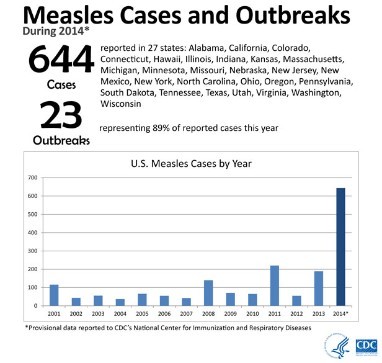 NIH NIAID
NIH NIAID
California Measles Outbreak Reminds Us of the Importance of Vaccines
In 1963, the measles vaccination program began in the United States. Before that, three million people contracted the virus annually and of those infected 500 died from it and thousands more were sent to the hospital.
You wouldn’t know it by today’s headlines, but measles was considered “eliminated” in the United States. Elimination is defined by the absence of transmission for a twelve month period. According to the Journal of the American Medical Association in 2001, the cases of confirmed measles incidents were one in one million of the population and the Center for Disease Control had officially reported native measles to be eradicated from the U.S. The goals set out to eliminate measles from the country back in 1978 were about to be realized.
But as I said before, the headlines today do not reflect the campaign that began almost five decades ago:
California Measles Cases Still Increasing / CNN
More Than 1,000 in Arizona Are Watched for Measles / New York Times
2015 U.S. measles outbreak already at 84 cases / USA Today
Measles is a very contagious disease with an extremely high R0 value. In this case, an R0 value is an estimate of the number of people that a single infected person can transmit the disease to. Ebola has a value of two, SARS a value of four, polio is five, and measles stands at the top of the pack at eighteen. The transmission is so high because it is one of the few viruses that have successfully become airborne, meaning it does not need water droplets or any organic matter to sustain it. Both the history of the virus and the high transmission rate are astonishing facts and make the milestones in the fight to eradicate measles all the more impressive.
The spotlight is now back on the virus with the outbreak in California. With over seventy confirmed cases across half a dozen states, the outbreak has been traced to Disneyland over the winter holidays and highlights the dangers of not immunizing children that are then exposed to communal areas. The number of infected this month alone has already outpaced the number for all of 2004.
However, claims of a massive return of measles are largely exaggerated, we are not on the road towards the millions of cases and the thousands hospitalized situation before vaccinations were commonplace. But the rise of measles cases is a serious concern and has highlighted underlying problems of the healthcare system. Hospitals are not ready for the influx of measles cases and many doctors in California, the hardest hit state, had to be retrained and reeducated to treat a disease that nowadays is mainly taught as theory in medical school. As more cases are documented it is challenging the readiness of the health system. Hospitals and clinics are looking towards state and federal departments of health for an institutionalized response to direct efforts.
Many of us think of vaccinations as a benefit for only personal reasons. It is not just immunization of our own bodies that health workers are worried about. The reason why the U.S. sees few large scale outbreaks is because of “herd immunity,” meaning a high percentage of the population is immunized against a particular virus. This is not just to stem the spread of a virus from person to person but also to prevent the virus from duplicating itself, otherwise granting more opportunities to mutate and change in a way that could be beneficial to it and very negative to humanity. Outbreaks of preventable diseases are a challenge to health workers that have never witnessed a large scale infection in their lifetime and give new life to the virus to alter itself either against the vaccine, the rate of transmission, or the medium of transmission.
In 2014, there were 644 confirmed cases of measles and over twenty outbreaks of the disease. The Disneyland outbreak is not a new occurrence, just a large one. There have been numerous smaller outbreaks in California all of last year. The growth of these outbreaks is a result of an ill-informed and ill-advised movement that has grown out of a debunked study; discredited by every science journal that has investigated it, including the original publisher. The dangers of this falsified study have resulted in large scale outbreaks in England and the current outbreak in California. The controversy centers around a particular ingredient called thimerosal, a preservative used to prevent fungal or bacterial growth in the vaccines. But the fears today are largely unfounded. The ingredient has not only been proven to be safe since the 1930s but its usage has also been discontinued from most manufactured vaccinations.
“At this point one can conclude that evidence does not support the idea that the MMR (Measles, Mumps, and Rubella vaccine) causes autism.”
– Professor Simon Baron Cohen, Director of the Autism Research Centre, Cambridge University
Parents who choose not to vaccinate their children are gambling with the health security of their child and putting others that may be too young to receive the vaccine, at risk. There is no acceptable base for distrust in vaccinations and in fact, as world travel continues to expand, an even greater need for parents to vaccinate their children against preventable diseases that still exist in other parts of the world.
Vaccines are a significant part of our public health policy resulting in the dramatic decrease of deadly diseases over the past sixty years. Diseases that once tore apart families and plagued entire nations became preventable. Until a 100% eradication level is reached for measles around the world, it is the job of health workers to not only educate and advocate for vaccinations but institutionalize a response for all diseases, even ones that have been considered “eliminated.”







[…] On Our Flashpoint Blog California Measles Outbreak Reminds Us of the Importance of Vaccines […]
[…] California Measles Outbreak Reminds Us of the Importance of Vaccines […]